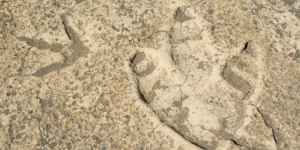Historic Discovery: 66 Dinosaur Footprints Found at Australian School Reveal Jurassic Secrets
A Hidden Treasure in Plain Sight
For two decades, an unassuming rock slab at a high school in Biloela, Australia, concealed an extraordinary treasure—dinosaur footprints.
This seemingly commonplace 1.5-meter-long slab remained largely unnoticed until paleontologists discovered that it held 66 fossilized footprints from 47 individual dinosaurs.
These footprints belong to the ichnospecies Anomoepus scambus, and this assemblage represents one of the densest concentrations of dinosaur footprints per square meter in Australia.

The Discovery
The rock slab has been a fixture in the school for 20 years, serving as a walkway in the schoolyard. Initially, it was known to be around 200 million years old and contained visible fossil footprints, but the extent of its significance was not recognized.
According to Dr. Anthony Romilio from the University of Queensland, the slab’s importance became apparent only after a detailed examination using advanced technology .
Significant Findings
The team’s research uncovered 66 distinct footprints that vary in size from 5 to 20 centimeters in length .
These fossils provide a unique glimpse into the behavior and environment of early Jurassic dinosaurs. Remarkably, this concentration of footprints per square meter is one of the highest documented in the country.
The footprints likely indicate that these small, three-toed, bipedal herbivorous dinosaurs were moving along or crossing a river, shedding light on the prehistoric landscape they inhabited .
What makes this discovery even more remarkable is the context. The rock slab from the Callide Mine is an example of trace fossils standing in when bone fossils are scarce.
This is particularly crucial for the Early Jurassic period in Australia, where no dinosaur bone fossils have been discovered.
Trace fossils like these footprints provide vital information about the types of dinosaurs that roamed the area millions of years ago.
The Role of Paleontology
| Aspect | Details |
|---|---|
| Trace Fossils | Trace fossils, often underestimated, provide significant insights into dinosaur behavior, movement, and environment, filling gaps left by the absence of bone fossils |
| Footprints | Footprints helped identify the Anomoepus scambus ichnospecies, contributing to understanding the global distribution of small ornithischian dinosaurs during the Early Jurassic period |
| Exploration | The discovery invites further exploration in the Callide Mine region and other locations, suggesting that more remains to be uncovered |
| ️ Technology | Advanced imaging technologies have been crucial in revealing ancient secrets, showing how modern science can shed light on prehistoric life |
Advanced Technology Reveals Ancient Secrets
The Role of Technology in Paleontology
Paleontology may seem like a field grounded in dusty dig sites and ancient bones, but modern technology is revolutionizing this area of study.
The recent discovery at a Biloela high school in Australia underscores this perfectly.
The seemingly ordinary rock slab that lay exposed for 20 years was transformed into a significant paleontological find through advanced technological techniques.
Uncovering Hidden Details with 3D Imaging
The rock slab, embedded with 66 footprints from 47 individual dinosaurs, held its secrets for years.
It was only with the help of 3D imaging and specialized light filters that scientists could delve deeper.
These advanced imaging tools revealed a plethora of hidden details, including the precise sizes and shapes of the footprints, and the subtleties in their depressions that the naked eye would struggle to discern.
Surprising Diversity in Footprint Sizes
The footprints themselves varied widely in size, ranging from a mere 5 centimeters to a substantial 20 centimeters in length.
This variation offers intriguing clues about the different sizes and age groups of the dinosaurs that once roamed in this region .
The smaller footprints could belong to juvenile dinosaurs, while the larger ones indicate fully grown adults. Each footprint tells part of the story of a vibrant ecosystem that existed about 200 million years ago ⏳.
Analyzing Trackway Sequences
Through meticulous analysis, researchers identified 13 distinct trackway sequences.
Each sequence is a set of consecutive footprints from a single dinosaur, allowing scientists to piece together the paths these ancient creatures walked ♂️.
This is critical for understanding their behavior, movement patterns, and interactions within their environment.
Additionally, there were 34 isolated footprints, representing individual steps that did not form complete trackways.
These isolated prints are just as vital, offering snapshots of the varied activities and moments in the life of these ancient animals.
Reconstructing Ancient Environments
With advanced technology, paleontologists are doing more than just identifying footprints; they are reconstructing ancient ecosystems.
The details uncovered by 3D imaging suggest that these dinosaurs were traversing a riverine environment .
Without ripple marks, it’s tough to delineate the river’s flow direction, but the footprint directions show dinosaurs moving in different directions across or alongside the river.
A Transition to Broader Implications
The use of technology has not only uncovered new details about these footprints but has also opened up new pathways for understanding dinosaur behavior and the environments they inhabited.
This highlights the instrumental role that technology plays in modern paleontological research. Moving forward, these insights will continue to shape our understanding and pave the way for future discoveries in unforeseen locations, enriching our knowledge of ancient life on Earth .
The Anomoepus Scambus: A Glimpse into the Early Jurassic
Discovering the Dinosaur Footprints
The dinosaur footprints found at the Biloela high school rock slab were a remarkable find, not just for their sheer number, but also for the insights they provide into the lives of early Jurassic dinosaurs.
These 66 fossilized footprints belong to the ichnospecies Anomoepus scambus, a group of herbivorous dinosaurs that roamed the earth around 200 million years ago .
Characteristics of the Anomoepus Scambus
The footprints on the slab demonstrate that Anomoepus scambus was a three-toed, bipedal dinosaur.
The size of the tracks ranges from 5 to 20 centimeters in length, indicating a variety of sizes among the dinosaurs, likely representing different age groups .
These dinosaurs had leg lengths ranging from 15 to 50 centimeters and possessed robust bodies suitable for their lifestyle .
Their diet mainly consisted of vegetation, inferred from their physical characteristics and the environments they lived in.
Behavior and Environment
The configuration of the footprints suggests a fascinating snapshot of their behavior.
The tracks appear to show the dinosaurs moving along or possibly crossing a river. This evidence, found in the direction and distribution of the footprints, adds a layer of context to their day-to-day activities .
The presence of a possible river environment helps paleontologists understand the natural habitats these dinosaurs favored, which were likely rich in plant life .
Additionally, the advanced 3D imaging and light filters used to study the rock slab revealed 13 trackway sequences and 34 isolated footprints.
This detailed analysis not only uncovered information about the dynamics within a group of these dinosaurs but also provided a broader understanding of their movement patterns and interactions in a riverine setting ️.
A Unique Australian Find
This find is significant for Australian paleontology, as it is the only direct evidence of dinosaurs from the Early Jurassic period in the country.
The trace fossils, such as these footprints, are invaluable in piecing together historical biodiversity, especially in regions where bone fossils are rare or absent .
The distribution of these tracks also contributes to global research on the dispersal and habitat range of early ornithischians, the group to which Anomoepus scambus belongs.
This group included herbivorous dinosaurs, many of which played vital roles in their ecosystems .
This remarkable discovery at Biloela opens up new possibilities for further exploration and study, highlighting the often-overlooked importance of trace fossils in our understanding of prehistoric life.
This insight into the daily lives and environments of early Jurassic herbivores enriches the scientific narrative by filling gaps that bone fossils alone cannot provide.
Even more intriguing is the potential for additional discoveries in the Callide Mine region, suggesting we may yet uncover further secrets of the past embedded in everyday settings .
Significance for Australian Paleontology
The discovery of 66 fossilized dinosaur footprints in a high school rock slab provides a groundbreaking insight into the Early Jurassic period in Australia.
These footprints, belonging to the ichnospecies Anomoepus scambus, represent the only direct evidence of dinosaurs from this time in the region.
Unique Perspective from Trace Fossils
Trace fossils, such as these footprints, are invaluable in paleontology, particularly in areas where bone fossils are scarce or nonexistent.
The footprints provide essential clues about the presence and behavior of dinosaurs, enabling scientists to piece together a vivid picture of the prehistoric ecosystem.
Dr. Anthony Romilio, the lead author of the study, points out that while trace fossils are often overlooked, they hold significant information.
In Australia, where dinosaur bone fossils from the Early Jurassic period have not been discovered, these footprints serve as the primary evidence of the types of dinosaurs that existed during this epoch.
Insights into Dinosaur Behavior
The footprints reveal that these dinosaurs were three-toed, bipedal herbivores with leg lengths ranging from 15 to 50 centimeters.
The intricate details captured in these prints provide a snapshot of the dinosaurs’ activities and behaviors, showing movement along or across a river.
As Dr. Paul Olsen of Columbia University states, such trace fossils offer “a dataset parallel to bones,” which helps track the global distribution and behaviors of early ornithischian dinosaurs.
Broader Implications for Paleontology
The discovery in Biloela, Australia, isn’t just a local curiosity; it has broader implications for understanding global dinosaur distribution.
The footprints of Anomoepus scambus align with similar fossils found in other parts of the world, reinforcing the idea of a wide-ranging distribution of early ornithischians.
This find allows paleontologists to compare data across continents, thus contributing to a more comprehensive understanding of dinosaur evolution and migration patterns.
Potential for Future Discoveries
The significance of this discovery extends beyond the known footprints.
The rock slab from the Callide Mine highlights the potential for more fossil findings in the region.
As more areas are surveyed, additional trace fossils may be uncovered, offering new opportunities for exploration and study.
This breakthrough not only enriches our knowledge of prehistoric life but also paves the way for future investigations into Australia’s rich paleontological history.
Each footprint, meticulously preserved over millions of years, This brings us one step closer to uncovering the secrets of the universe ancient world.
Additional Unexpected Discoveries
Australia’s landscape continues to surprise paleontologists, revealing fascinating glimpses into its prehistoric past in the most unexpected places.
After the incredible discovery of 66 dinosaur footprints in a school rock slab, further research uncovered even more trace fossils in locations that were seemingly ordinary.
Unearthed Fossils in Unlikely Places
Two additional fossil sites were discovered, each with its own unique story.
One of the most intriguing finds was a massive rock used as a parking lot marker at Callide Mine.
This heavy 2,000-kilogram boulder, placed there without much thought, held two distinct dinosaur footprints.
Initially unnoticed, these prints bring to light the potential wealth of paleontological evidence hidden in everyday surroundings.







